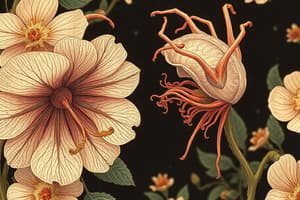Podcast
Questions and Answers
Which type of reproduction involves the fusion of gametes?
Which type of reproduction involves the fusion of gametes?
- Clonal reproduction
- Bacterial reproduction
- Asexual reproduction
- Sexual reproduction (correct)
What is a key characteristic of asexual reproduction?
What is a key characteristic of asexual reproduction?
- Genetic exchange between parents
- Combination of gametes
- Variety in species
- Offspring genetically identical to parent (correct)
Why does sexual reproduction produce a great variety of species?
Why does sexual reproduction produce a great variety of species?
- Variety in species is due to the combination of gametes from both males and females (correct)
- Random assortment of alleles does not play a role
- Due to the lack of chromosomes
- Because each individual has exactly the same genes as its ancestor
Which organisms typically reproduce asexually?
Which organisms typically reproduce asexually?
What is the main difference between asexual and sexual reproduction?
What is the main difference between asexual and sexual reproduction?
How does asexual reproduction contribute to genetic diversity?
How does asexual reproduction contribute to genetic diversity?
What specifically refers to the joining of sperm and egg in sexual reproduction?
What specifically refers to the joining of sperm and egg in sexual reproduction?
Which type of reproduction involves the fusion of male and female pronuclei resulting in a single nucleus with four complete sets of chromosomes?
Which type of reproduction involves the fusion of male and female pronuclei resulting in a single nucleus with four complete sets of chromosomes?
What is the function of meiotic cell division in the life cycle of organisms?
What is the function of meiotic cell division in the life cycle of organisms?
How does a zygote differ from a gamete?
How does a zygote differ from a gamete?
What process ensures increased genetic variability among offspring?
What process ensures increased genetic variability among offspring?
Which stage in an organism's life cycle involves only germline cells dividing to produce gametes?
Which stage in an organism's life cycle involves only germline cells dividing to produce gametes?
Study Notes
Reproduction is the process by which organisms create new individuals of their own kind. There are two main types of reproduction: asexual and sexual. Asexual reproduction occurs without the fusion of gametes, while sexual reproduction involves the union of male and female reproductive cells called gametes. Let's explore these processes further.
Asexual reproduction is the production of offspring from a single parent without any genetic exchange between parents. This method of reproduction produces genetically identical copies of the parent organism. Examples of this form of reproduction can be seen in bacteria, some plants, worms, insects like aphids, spiders, flowering plants such as mosses and ferns, algae, and fungi. In this type of reproduction, there is little or no change in gene structure during development, so each individual produced has exactly the same genes as its ancestor.
Sexual reproduction, on the other hand, involves the combination of gametes from both males and females, resulting in offspring with unique combinations of traits inherited from both parents. This type of reproduction generates a great variety of species because every individual possesses a different set of chromosomes. Sexual reproduction allows for variety in species due to random assortment of alleles. It also helps maintain stable populations despite fluctuations in environmental conditions; if one allele becomes more common, others may become less frequent, thus maintaining stability within the population.
Fertilization, another aspect of sexual reproduction, refers specifically to the joining together of sperm and egg. When the egg is released from the ovary into the fallopian tube it meets the sperm and they combine (fertilize) to make an embryo. The resultant zygote contains half of the maternal DNA, making up the diploid number of chromosome pairs, and half paternal DNA, forming the haploid set. Fusion of the male and female pronuclei results in a single nucleus containing four complete sets of chromosomes. The early stages of life cycle involve multiple rounds of cell division before morphogenesis begins, leading eventually to the formation of an adult organism.
Life cycles refer to the series of changes undergone by an organism over time, including growth, maturity, senescence, death, and rebirth. They often consist of numerous stages, sometimes involving major physical transformations. These stages can include a multicellular stage where many somatic cells divide rapidly, followed by a meiotic phase when only germline cells divide, producing gametes with half the normal amount of chromosomes. This process ensures increased variability among offspring through segregation and independent assortment of chromosomes in gamete formation.
In conclusion, organisms reproduce either sexually or asexually depending on whether they need genetic variation for survival. Both methods produce offspring capable of surviving in their environment, ensuring continuation of the species. Understanding these mechanisms provides insight into how evolution shapes biological diversity and adaptation across generations.
Studying That Suits You
Use AI to generate personalized quizzes and flashcards to suit your learning preferences.
Description
Explore the concepts of asexual and sexual reproduction, including the process of fertilization, genetic variation, and the stages of life cycles. Learn how different organisms create new individuals and how these processes contribute to biological diversity and species survival.




